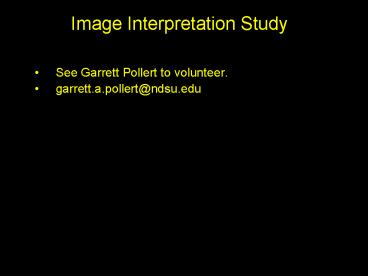Image Interpretation Study PowerPoint PPT Presentation
1 / 25
Title: Image Interpretation Study
1
Image Interpretation Study
- See Garrett Pollert to volunteer.
- garrett.a.pollert_at_ndsu.edu
2
Chapter 17
- Multiple Regression
- Continued
3
Semipartial correlations
- Transitive tendencies of correlations
- If predictor X1 is correlated with a criterion
and - The predictors are correlated with each other
- One should expect that the predictor X2 will be
correlated with the criterion. - Example
- Suppose Premorbid Adjustment and Psychiatric
Rating are measuring the similar things, ( thus
they are correlated) and - Psychiatric Rating can predict time to relapse (
thus they are correlated ) - So, we expect Premorbid Adjustment also to
predict time to relapse ( hence be correlated ) - The question Does Premorbid Adjustment predict
relapse just because it is like Psychiatric
Rating, or does Premorbid Adjustment add some new
information?
4
Semipartial correlations
- Graphically, the part that X2 contributes on its
own is part B shown below. - This is also the amount of variance that X2
contributes if X1 is held fixed.
5
Semipartial correlations
- What is the relationship between correlation and
explained variance? - Explained variance is represented by area in the
Venn diagrams.
6
Semipartial correlations
- This correlation related to the explained
variance (unique to X2, or X1) is called the
semipartial correlation. - How do we calculate it?
7
Semipartial correlations
- The following formula is used to calculate the
semipartial correlation - The notation 1.2 indicates correlation of 1,
holding 2 constant.
8
Semipartial correlations
- The relationship between semipartial correlation
and B. - Didnt we say that we were calculating B in order
to compensate for the overlap between what is
explained by X1 and X2? - The difference is that the Bs share the
overlapping variance, whereas a semipartial
correlation pertains only to variance unique to a
single predictor.
9
Semipartial correlationExample
- Recall the correlation values from our
schizophrenia example.
10
Semipartial correlation, Betas (Bi) and the Venn
Diagram
11
Semipartial correlation, Betas (Bi) and the Venn
Diagram
12
Semipartial correlation, Betas (Bi) and the Venn
Diagram
13
Suppressor variables
- Normally the semipartial correlation is less than
the validity riy. - But, what if r2y is 0 or very small?
14
Suppressor variables
- The semipartial correlation can actually
increase! - Example
- Suppose we are studying the relationship weight
and height as predictors of cholesterol level. - Height and weight are correlated.
- Weight and cholesterol are correlated.
- But height and cholesterol are not correlated.
15
Suppressor variables
- Example (continued)
- So we might get correlations like this
16
Suppressor variables
- How does this happen?
- Excess weight is associated with high
cholesterol. - However, height caused weight is unrelated to
cholesterol. - Therefore height is just excess variance when we
are trying to predict cholesterol from weight. - By including height in our theory we can
eliminate the extra variance it adds to our
predictions. - Height is called a suppressor variable.
- This is similar to what we did with matched t
tests and 2 way ANOVAs.
17
Suppressor variables
- Effect on the regression equation
- Suppressor variables also affect B.
- In our example we get
- The -.2 acts as a correction factor for tall
people.
18
Complementary variables
- There is another situation where the semipartial
correlation is greater than the validity. - If two predictors are negatively correlated but
each is positively correlated to the criterion,
this is a good thing. - It is good because R2 is increased.
19
Complementary variables
- Positive r12 represents overlap in our Venn
diagram. - Negative r12 represents a negative overlap, which
is a weird thing! - Example
- Aggression and friendliness are negatively
correlated. - Aggression is positively correlated with
leadership ability. - Friendliness is also positively correlated with
leadership ability. - Thus a person who is both friendly and aggressive
would make a rare but excellent leader ( Y will
be high ).
20
Complementary variables
- Example of high negatively correlated predictors.
21
Partial correlation
- Sometimes a variable affects both a predictor and
a criterion. - Thus, the relationship between the predictor and
criterion may be distorted. - Example
- We want to know if coffee consumption can predict
cholesterol levels. - However, we know that stress can affect both
coffee consumption and cholesterol. - What can we do if we want to study this
prediction free of stress effects?
22
Partial correlation
- We want to remove the distorting variable from
our universe. - This variable is often called a nuisance variable
or covariate. - This are also treated in analysis of covariance
or ACOVA.
23
Partial correlation
- What we want then is the partial correlation.
- Which is the square root of the area
- A / (Area A Area D)
- D CL - Everything but the stress and coffee
variance
24
Partial correlation
- Calculating partial correlation
25
Exercises
- Page 525
- 3, 5 c, 6, 8 b, 9 a (skip significance test), 10
a

